What do you know about couscous? That it’s a trendy new cereal that has migrated from restaurants to our kitchens? Actually, couscous has a very rich history.
According to one version, couscous was known as far back as the 3rd century B.C. This is evidenced by archaeological finds in modern Algeria. In the tombs of that time, cooking utensils very similar to couscoussiers (French: couscoussiers) – special vessels for cooking couscous were found.
According to another, the appearance of couscous dates back to the 12th-13th centuries and falls in the heyday of the Almohad Caliphate. This North African Berber Muslim empire controlled most of the Iberian Peninsula and North Africa.
But couscous did not take root in the Pyrenees. There are no mentions of it in Spanish or Portuguese medieval cookbooks. But in North Africa, couscous dishes could be found on the table of a poor man or at the richest weddings.
The only thing they all agree on is that North Africa (Maghreb) can rightfully be considered the homeland of couscous. But enough of the various historical studies. Let’s turn directly to the main character of our review.
Contents:
What is Сouscous?
Like historical hypotheses, there are many opinions about what couscous is. Some think it is a kind of millet. Others say it is a slightly larger semolina, others say it is a small paste. Each version is right in its own way.
Couscous is not really a grain, although it looks like one. In some regions it is made from barley or millet, but mostly it is made from semolina of durum wheat with high protein content and is a kind of pasta.
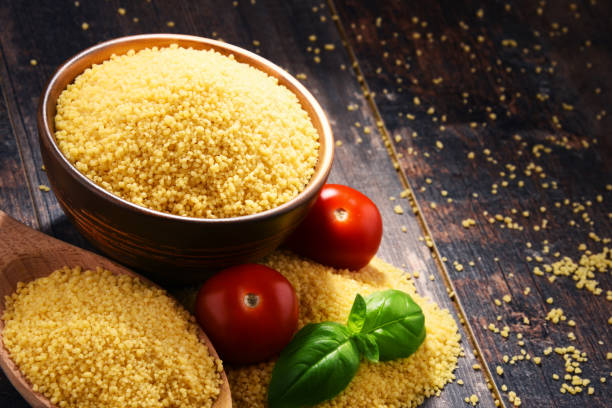
In ancient times couscous was made by hand. Nowadays couscous is cooked by machine by soaking and then steaming, which makes it a fast food.
How couscous was made in the Maghreb
Sometimes all the women of the settlement gathered to cook couscous, because it is a very labor-intensive process.
The semolina was poured onto a concave wooden board and sprinkled with water. Then they rubbed it with their hands until the groats gathered into small balls, about one and a half millimeters in diameter.
It was this process that gave both the name of the cereal itself and of the dishes made from it. It comes from the Arabic kaskasa (to grind) and first appeared in French in the 17th century.
Then the balls were dusted with flour so they wouldn’t stick together, and sifted through a special sieve, sifting out the small ones. Those that remained in the sieve were sent to drying, and the discarded ones were returned for a second cycle. This process continued until all the semolina was made into tiny couscous pellets.
The possibility of long-term storage, ease of carrying and cooking made couscous a staple food of nomadic peoples and traders.
What does couscous taste like?
The flavor of couscous, a beloved staple in many cuisines, is often described as mild, versatile, and subtly nutty. However, the taste and texture can vary slightly depending on the type of couscous and how it is prepared.
Raw Couscous
Raw couscous, straight from the package, has a very neutral, almost bland flavor, akin to pasta or rice. The granules are hard and would not be enjoyable to eat without cooking.
Cooked Couscous
Once cooked, the couscous granules soften and fluff up, providing a pleasingly light and fluffy texture. The taste remains mild and neutral, a little like pasta, with a subtle, nutty undertone. This relative neutrality is one of the reasons why couscous is so versatile — it can easily take on the flavors of whatever ingredients or spices you pair it with.
Moroccan Couscous
Moroccan couscous, which is the smallest type, absorbs flavors particularly well due to its size. When cooked, it has a light, delicate flavor and a slightly grainy texture. It’s often served with stews or tagines, where it absorbs the rich sauces and complements the stronger flavors of the dish.
Israeli (Pearl) Couscous
Israeli or pearl couscous offers a chewier texture due to its larger size. The taste is slightly nuttier compared to Moroccan couscous, owing to the toasting process it undergoes during production. This variant is great for salads and pilaf-style dishes, where its distinct shape and texture can really stand out.
Lebanese (Maghreb) Couscous
Lebanese, or Maghreb couscous, has the largest granules of all and therefore has the chewiest texture. This type of couscous retains a bit of firmness even after cooking, which gives dishes a satisfying bite. The taste is similar to the Moroccan variety, though it doesn’t absorb flavors quite as readily due to its size.
Nutritional value
According to research by the U.S. Department of Agriculture (USDA), 100 grams of whole-grain couscous contains:
- proteins – 12.8 g;
- fats – 0.64 g;
- carbohydrates – 77.4 g;
- fiber – 5.0 g.
The caloric value of this amount of product is 376 kcal (1574 kJ).
Couscous is a valuable storehouse of vitamins and minerals. One serving of porridge contains more than half of a person’s daily requirement of manganese, a quarter of phosphorus, vitamins B3 and B6, about 20% of copper and magnesium.
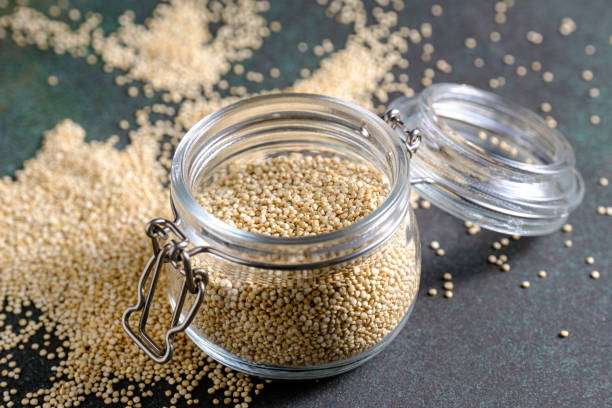
People with diabetes or wheat allergies should be especially careful with couscous. They contain gluten, and the glycemic index of couscous is slightly higher than that of soybeans, pearls, beans, and lentils.
Types of Couscous
There are mainly three distinct types of couscous available worldwide, each carrying its unique history, use, and characteristics. These include Moroccan, Israeli or Pearl, and Lebanese or Maghreb couscous.
Moroccan Couscous
Considered the traditional variant, Moroccan couscous is the smallest in size and often the quickest to prepare. The grains are about the size of semolina, and it cooks in a breeze.
One simply needs to steep it in hot water or flavorful broth and let it sit for about 5-10 minutes. Due to its small size, Moroccan couscous is perfect for absorbing the flavors of the dish it accompanies, making it a versatile base for various recipes.
Pearl or Israeli Couscous
Israeli couscous, also known as pearl couscous or ptitim, is significantly larger than its Moroccan counterpart and has a shape comparable to that of peppercorns. This type was invented in Israel during the mid-twentieth century as a rice substitute during the Arab-Israeli war. As it was personally promoted by Israel’s first prime minister, David Ben-Gurion, it’s sometimes referred to as Ben-Gurion rice.
Unlike the other variants, Israeli couscous undergoes a toasting process, which gives it a distinctive nutty flavor. The grain’s consistency is more pasta-like due to its size and the cooking process, which involves boiling it like traditional pasta for approximately 10-15 minutes. This couscous type is popularly used in salads and stews.
Lebanese or Maghreb Couscous
Lebanese couscous, also known as Maghreb couscous, named after the region in North Africa where it’s commonly used, is the largest in size. This couscous variant requires a bit more cooking time, typically around 15-20 minutes, due to its larger grains.
In terms of flavor, it is similar to Moroccan couscous but offers a distinct mouthfeel because of its size. The grains are often about the size of small peas, providing a more substantial texture. It’s traditionally used in slow-cooked stews and tagines, where it soaks up the rich flavors of the cooking juices.
It’s fascinating to note that these three types of couscous, while seemingly similar, offer distinct culinary experiences. This versatility explains why couscous continues to be a cherished staple across various cuisines, from the aromatic kitchens of the Middle East and North Africa to the bustling food scenes of the West.
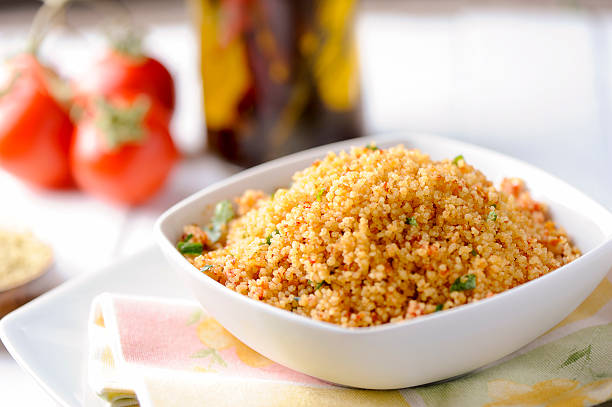
How to Cook Couscous?
Handmade couscous needs to be re-hydrated during cooking. Therefore, steaming is the ideal way to cook it. Moroccan couscous can simply be steamed, while pearl and Lebanese couscous should be steamed a bit.
It’s easy to tell which type of couscous you have. The Moroccan is a little bigger than semolina, the Israeli is the size of a small pearl, and the Lebanese is about the size of a pea.
Below I will elaborate on each of the cooking methods, so that you can prepare a delicious dish, preserving its maximum useful properties.
How to make couscous
If you wish to make a side dish of pearl or Lebanese couscous, it must be pre-broiled.
Melt the butter in a frying pan over medium heat and add the couscous. Fry, stirring constantly, until it browns to a golden color.
Add any liquid to the pan. It can be chicken or vegetable broth or just water. Stir in the couscous and turn up the heat.
When the contents come to a boil, turn the heat down to low and let simmer for 6-7 minutes for pearl couscous or 9-10 for the larger Lebanese.
If you’re making couscous with vegetables, it’s time to add them to the pan. It can be bell peppers, tomatoes, eggplants. Don’t forget to add your favorite seasonings and spices. Constantly stirring bring the dish to the readiness. You can evaporate the excess liquid by increasing the heat.
If you just want to boil the couscous, cook for another 5-7 minutes and then drain off the excess water.
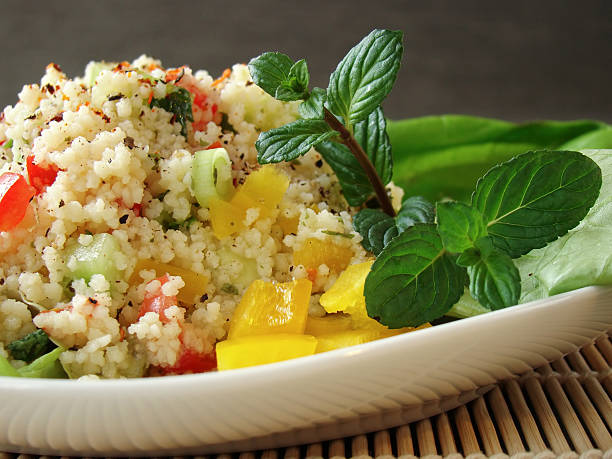
How to steep couscous
Always use instant couscous for steaming. It is desirable to use a container with a wide bottom. In this case, the groats are more evenly distributed and do not stick together.
Put the couscous in a suitable container. Add salt and spices. The latter can be whatever you like. They will improve the flavor and aroma of the porridge. Try cooking with ground black pepper, cumin and smoked paprika.
If you are making sweet fruit porridge, use vanilla, cinnamon, cardamom, ginger, or allspice. Sugar and butter are better added to the already cooked porridge.
Mix the grits with the spices, if you want you can add extra virgin olive oil. Pour boiling water to cover the couscous by about 1 cm.
The proportion of water can vary and depends both on personal preference and on the size of the pot in which you are cooking. It is best to add the water in one sitting. If couscous is new to your kitchen, start with the proportion: 1 ¾ cup of boiling water per 1 cup of grits.
The container after pouring boiling water, be sure to close tightly. A well-fitting lid or a plate will do for this purpose. You can also use cling film or foil. The water will be absorbed much faster, and the porridge will turn out more crumbly.
You can use chicken or vegetable broth instead of water. If you have salted it while boiling, there is no need to add salt to the couscous. The full steaming time is 5-10 minutes.
After this time, simply stir the cooked dish with a fork, whisking it a bit. Always stir the couscous with a fork. If you use a spoon for this purpose, the porridge may turn out lumps.
If all these instructions are followed, each grain of couscous will absorb the right amount of water and the porridge will turn out nice and fluffy.
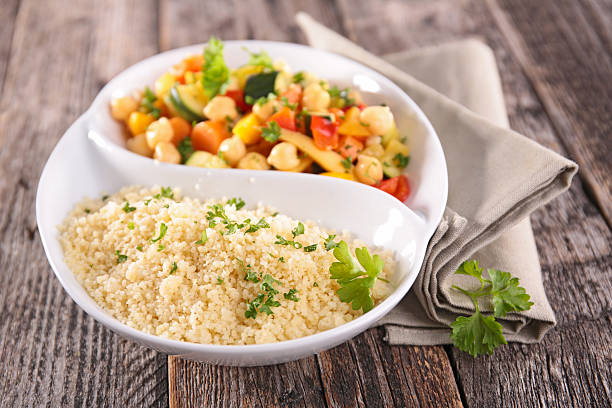
How to cook couscous in a multicooker
Pour the required amount of water or broth into the bowl of the multicooker and turn on the “Rice Cereal” mode. While the liquid is boiling, mix the couscous with spices, salt or sugar.
After boiling, pour the mixture into the bowl of the multicooker and close the lid. Further steps will depend on the type of couscous to be cooked.
- If you cook pearl couscous – turn on the “Preheat” mode for 5-10 minutes.
- To cook Israeli – program the multicooker in the mode “Rice-Grits” for 10-15 minutes.
- If you have a Maghreb variant for lunch – add another 5 minutes to the cooking time.
It’s easy to make couscous porridge in the multicooker. Especially children love it. To do this, you need to select the mode “Milk porridge”, and leave the cooking time the same.
How is couscous prepared in the Maghreb?
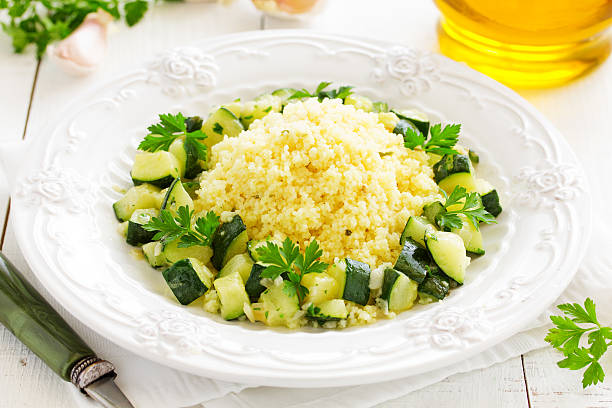
Cooking couscous in North Africa is a real culinary ritual. Most of us don’t even bother with meat dishes.
The porridge is cooked in a special dish, a borma. It looks something like a steam cooker. The borma consists of two parts. The lower part, the tanjera, is used to boil the broth. The upper part, keskes or kiskas, has a mesh bottom and is used to steam couscous from the broth. In French, such utensils are called couscousier.
An hour before cooking, soak the saffron in a small amount of water. When it is steamed, proceed directly to cooking couscous.
Pour half of the water in the bottom of the borma, add salt, bay leaf, cardamom and cinnamon stick. A larger amount of water will make the porridge too watery. While all this is boiling, previously soaked saffron is diluted with boiling water to a nice lemon color. Salt is added to taste, and everything is stirred.
In another container, prepare the necessary amount of cereal and pour a small amount of salted saffron water. At this stage couscous should not be stirred and steamed, because it will be lumpy or make one big pancake)
After all the water has been absorbed (in 10-15 minutes), the slightly swollen couscous is rubbed so that all grains are separated from each other. This should be started by carefully “shaving” the grits from the top. If you do not knead all the lumps at this stage, later it will be much more difficult.
Next, the couscous is sent to the upper bowl of the borma, where the water with spices is already boiling. After the steam begins to actively pass through the grits, they are dumped into a wide clay bowl and moistened with salted saffron water. Then the porridge is sent back to the couscouser.
To achieve even moistening of the couscous and to balance the cooking, these actions are performed twice. When the steam begins to pass through the grits for the third time – the porridge is ready.
It is recommended to dress the porridge while still warm with butter, extra virgin olive oil or soft blue cheese. It is believed that if you add oil at the beginning of cooking, couscous will not absorb the flavor of saffron and will be tougher. The porridge cooked in this way can be kept in the refrigerator for a week.
At Out of Africa in Mali, couscous cooked this way is served with mashed beets with ginger and orange, dried cranberries, mint, shallots and grapefruit, garnished with lettuce and goat cheese.
Couscous in cooking
Couscous is a very versatile side dish. It can be served with meat, fish and other seafood. It also harmonizes with various vegetables – bell peppers, tomatoes, eggplant, zucchini, beets, asparagus and carrots.
The combination of couscous with honey, cheese, nuts and fruit should be especially emphasized.
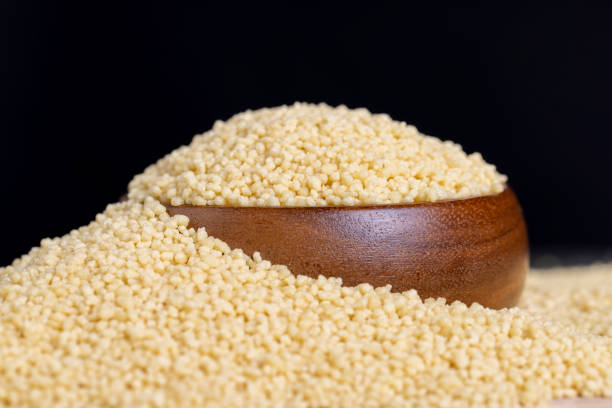
In the chart below, I’ve compiled additional ingredients that give couscous dishes a special flavor and sophistication.
| Ingredient | Quantity per 100 g of couscous | Note |
| Lemon | The zest of 1 lemon, 2 tablespoons of lemon juice | It will add brightness to the taste. This delightful side dish goes well with any main dish. Add at the beginning of cooking in broth or water. |
| Parmesan | 25-30 g | The perfect cheese side dish. Great for when there is absolutely no time to cook. It does not take you even 10 minutes to prepare it. Add it to hot porridge, grate it on a grater. |
| Mushrooms | 125 g of fresh mushrooms, 50-60 g of onions | Gives a tangy flavor. You can use as a separate dish or serve as a side dish to meat, such as juicy pork ribs. Pre-roast the mushrooms with onions. Two-thirds can be used for couscous, and one-third can be added to the porridge. This will give a special flavor and richness. |
| Cherry tomatoes | 200 g | Baked cherry tomatoes for a wonderful, concentrated spicy flavor, fresh ones for a bright and light flavor. Bake half the tomatoes in the oven until soft, drizzled with olive oil. This will take some time, but you can prepare them ahead of time. Cut the rest of the tomatoes fresh. |
| Chickpeas | 150 g canned chickpeas, coconut milk, curry | Fiber-rich chickpeas add a nice, nutty flavor to your dinner. And if you use coconut milk to make the couscous, you get a wonderful creamy texture. It goes great with curries. Another big plus of the recipe is that it is all-season. |
| Bananas, strawberries or any seasonal fruit | One banana, two strawberries (or other fruits), sugar or honey, cinnamon | A sweet, fruity breakfast will energize everyone in your family for the day. While the couscous is steaming, chop the fruit. You can use honey or maple syrup instead of sugar. Place the fruit on top of the cereal and sprinkle with cinnamon. |
| Egg | Egg – 1 egg, frying oil | A light side dish of couscous fried in egg with any vegetables is a great dinner idea in just 15 minutes. It cooks much faster than rice and can be served with any stewed vegetables. |
| Shrimp | 50 g of peeled boiled shrimp | Delicious couscous with shrimp will pleasantly diversify your menu and replenish your body with healthy minerals and trace elements. Shrimp can be replaced with calamari or seafood cocktail. Spicy Spanish chorizo will add a special flavor. |
| Broccoli or cauliflower | 100 g florets, olive oil, hazelnut, lemon juice | Bake the cabbage in the oven with a splash of olive oil. Meanwhile, prepare the couscous. Add roasted chopped hazelnuts if you want a gourmet flavor. Season with lemon juice. |
| Spices and herbs | By taste | Black pepper, paprika, turmeric, cumin, cayenne pepper, oregano, thyme, and sage are great with meat and vegetable dishes with couscous. The latter, by the way, interrupts the smell of fat. For fish – coriander, zira, cinnamon, mint, lime. For sweet fruit – cardamom, cinnamon, allspice. Please note that it is always better to add spices before you start cooking by mixing them with cereals. The exception is when you cook pearl couscous like pasta, draining the water after cooking. |
The main failures in cooking couscous and their causes
Unfortunately, not everyone can make delicious and fluffy couscous, especially the first time. Let’s break down the main problems.
The couscous is dry
Initially, not enough water was added to it. You can correct the mistake by adding more water, but the taste will not be as rich.
The porridge is sticky and watery
A little more liquid than necessary is added. You can try to evaporate the excess moisture in the pan.
The couscous came out lumpy
During cooking, the porridge was not whipped in time with a fork. You can try to fix the mistake with a fine mesh potato masher, but I don’t have much faith in success.
The porridge is bland, tasteless
The porridge may not be salty enough. Salt and add butter. The taste of the porridge will immediately change for the better. And don’t be afraid to experiment with spices while cooking.
In lieu of a conclusion

There is a legend in Jewish mythology that King Solomon fell madly in love with the Queen of Sheba, the legendary ruler of the Arabian kingdom of Saba. The feeling was so deep that the king completely lost his appetite. Not only Solomon’s health was in danger, but also the prosperity of the state itself.
The situation was saved by the ruler’s personal cook. He so skillfully prepared couscous with spices that the king regained his appetite and strength.
I hope that couscous will not only take its rightful place in your kitchen, but also help everyone in your family feel invigorated and healthy.
Sources
- Food Wishes
- Jamie Oliver
- Sarah Leach
- Asbell Robin – The New Whole Grain Cookbook
- Wayane Gisslen – Professional Cooking Study Guide
